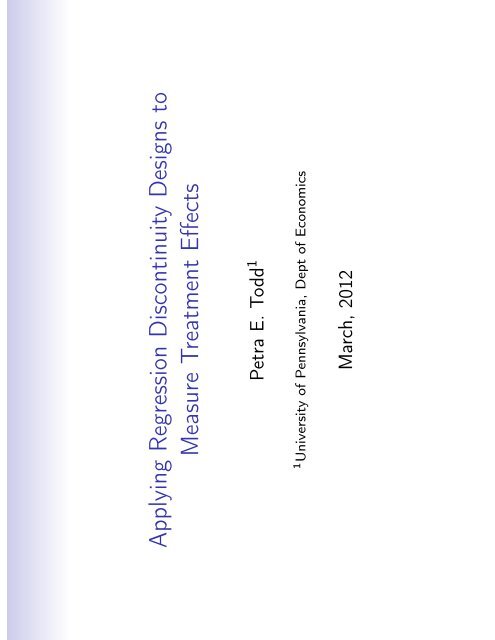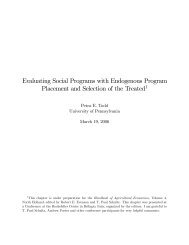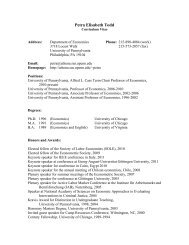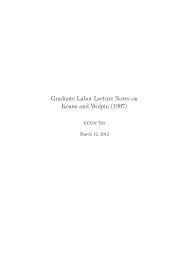Notes on Regression Discontinuity Methods - [athena.sas.upenn ...
Notes on Regression Discontinuity Methods - [athena.sas.upenn ...
Notes on Regression Discontinuity Methods - [athena.sas.upenn ...
Create successful ePaper yourself
Turn your PDF publications into a flip-book with our unique Google optimized e-Paper software.
Applying Regressi<strong>on</strong> Disc<strong>on</strong>tinuity Designs to<br />
Measure Treatment Effects<br />
Petra E. Todd 1<br />
1 University of Pennsylvania, Dept of Ec<strong>on</strong>omics<br />
March, 2012
Overview of RD design<br />
• Goal is to evaluate causal impacts of an interventi<strong>on</strong><br />
• Assignment to treatment is determined in part by the value of<br />
an observed covariate lying <strong>on</strong> either side of a fixed threshold<br />
(cut-off)<br />
• Design first introduced by Thistlewaite and Campbell (1960)<br />
to evaluate the effect of Nati<strong>on</strong>al Merit awards <strong>on</strong> career<br />
aspirati<strong>on</strong>s of award recipients.<br />
• Analyzed by Goldberger (1972) in the c<strong>on</strong>text of evaluating<br />
educati<strong>on</strong> interventi<strong>on</strong>s and Berk and Rauma (1983) in<br />
analzying effect of an unemployment benefit program <strong>on</strong><br />
recidivism rates.
• Many studies implicitly rely <strong>on</strong> n<strong>on</strong>linearities or disc<strong>on</strong>tinuities<br />
in the assignment rule (Black (1996) and Angrist and Krueger<br />
(1991)).<br />
• Since 1990’s, there has been a large number of studies in<br />
ec<strong>on</strong>omics and other fields applying and extending RD<br />
methods (will discuss many examples later)<br />
• New theoretical advances in interpretati<strong>on</strong> and estimati<strong>on</strong>
Potential Outcomes Framework<br />
• Potential outcomes associated with treated and untreated<br />
states<br />
Yi(0),Yi(1)<br />
• Framework laid out in Fisher (1951), Roy (1951), Quandt<br />
(1972), Rubin (1978)<br />
• Interest usually focuses <strong>on</strong><br />
Yi(1) − Yi(0)<br />
• Let Wi = 1ifuniti exposed to treatment, else Wi = 0.<br />
• Observed outcome<br />
Yi =(1 − Wi)Yi(0)+WiYi(1)<br />
= Yi(0)+Wi(Yi(1) − Yi(0))
Assignment to Treatment<br />
• Let (Xi,Zi) be a vector of covariates or pretreatment variables<br />
known not to be affected by treatment (e.g. pre-test score,<br />
age)<br />
• Assignment to treatment is determined either completely or<br />
partly by the value of Xi being <strong>on</strong> either side of a fixed<br />
threshold.<br />
• Yi(0) or Yi(1) may also be associated with Xi, butthe<br />
dependence is assumed to be smooth<br />
• Disc<strong>on</strong>tinuities in the c<strong>on</strong>diti<strong>on</strong>al distributi<strong>on</strong> of Yi (or in its<br />
c<strong>on</strong>diti<strong>on</strong>al expectati<strong>on</strong>) are attributed to a causal effect of<br />
treatment.
Two Types of Designs<br />
• Sharp Regressi<strong>on</strong> Disc<strong>on</strong>tinuity (SRD) Design<br />
Wi = 1{Xi ≥ c} (1)<br />
All individuals with covariates of c or greater are assigned to<br />
treatment.<br />
• We can use the disc<strong>on</strong>tinuity in the c<strong>on</strong>diti<strong>on</strong>al expectati<strong>on</strong> of<br />
the outcome given the covariate to uncover an average causal<br />
effect of treatment<br />
τSRD = limx↓cE(Yi|Xi = x) − limx↑cE(Yi|Xi = x) (2)
Two Types of Designs<br />
• Fuzzy Regressi<strong>on</strong>-Disc<strong>on</strong>tinuity (FRD) Design<br />
• Prob of receiving treatment need not change from 0 to 1 at<br />
the threshold, but there there is a disc<strong>on</strong>tinuous jump in the<br />
probability, so that<br />
limx↓cE(Wi|Xi = x) − limx↑cE(Wi|Xi = x) = 0<br />
or,equivalently,<br />
limx↓cPr(Wi = 1|Xi = x) − limx↑cPr(Wi = 1|Xi = x) = 0<br />
• Treatment effect can be obtained by the ratio<br />
τFRD = lim x↓cE(Yi|Xi = x) − limx↑cE(Yi|Xi = x)<br />
limx↓cE(Wi|Xi = x) − limx↑cE(Wi|Xi = x)<br />
(3)
Why?<br />
Assume c<strong>on</strong>stant treatment effect τFRD.<br />
Yi = Yi(0)+Wi[Yi(1) − Yi(0)]<br />
Yi = Yi(0)+WiτFRD<br />
limx↓cE(Yi|Xi = x)=<br />
limx↓cE(Yi(0)|Xi = x)+limx↓cE(Wi|Xi = x)τFRD<br />
limx↑cE(Yi|Xi = x)=<br />
limx↓cE(Yi(0)|Xi = x)+limx↑cE(Wi|Xi = x)τFRD
Take the difference, use the fact that E(Yi(0)|Xi = x) is c<strong>on</strong>tinuous<br />
at Xi = c and solve for τFRD.<br />
limx↓cE(Yi|Xi = x) − limx↑cE(Yi|Xi = x)=<br />
limx↓cE(Wi|Xi = x) − limx↑cE(Wi|Xi = x)τFRD<br />
τFRD = lim x↓cE(Yi|Xi = x) − limx↑cE(Yi|Xi = x)<br />
limx↓cE(Wi|Xi = x) − limx↑cE(Wi|Xi = x)
Interpretati<strong>on</strong> of FRD when treatment resp<strong>on</strong>se is<br />
heterogeneous<br />
• Assume that treatment effect varies by unit τFRD random<br />
• Let Wi(x) be the potential treatment status given cut-off<br />
point x, forx in a neighborhood of c.<br />
• Wi(x)=1ifuniti would take treatment if cut-off equals x<br />
• Assume m<strong>on</strong>ot<strong>on</strong>icity: Wi(x) is n<strong>on</strong>increasing in x at x = c
Define compliance status<br />
• Compliers: have<br />
limx↓Xi W i(Xi)=0,limx↑Xi W i(Xi)=1, (4)<br />
would get treatment if cut-off Xi or below, would not get<br />
treatment otherwise<br />
• Nevertakers: do not get treatment either way<br />
limx↓Xi W i(Xi)=0,limx↑Xi W i(Xi)=0 (5)<br />
• Always takers: get treatment either way<br />
limx↓Xi W i(Xi)=1,limx↑Xi W i(Xi)=1 (6)
For example, c<strong>on</strong>sider a program that assigns children with a<br />
pre-test score below a threshold to some remedial interventi<strong>on</strong> (e.g.<br />
asummerreadingprogram).<br />
• Compliers are children who participate in the program <strong>on</strong>ly if<br />
their test score is below the threshold and not otherwise. They<br />
comply with their assigned treatment status.<br />
• Always-takers are children who manage to receive the<br />
interventi<strong>on</strong> regardless (e.g. parents request that they attend<br />
the program)<br />
• Never-takers are children who do not attend the program even<br />
if assigned to it.
Interpretati<strong>on</strong> of τFRD<br />
In that case, τFRD gives the average treatment effect for compliers.<br />
(shown in Hahn, Todd and Van der Klaauw, 2001, building <strong>on</strong><br />
insights of Angrist and Imbens, 1994, about LATE estimators).
Another example of FRD Design<br />
• Van Der Klaauw (2002)<br />
• Studies effect of financial aid <strong>on</strong> college admissi<strong>on</strong>s<br />
• Associati<strong>on</strong> is ambiguous. More generous financial aid offers<br />
make students more likely to attend, but those students are<br />
also likely to have more generous offers from other places.<br />
• xi -numericalscoreassignedtocollegeapplicati<strong>on</strong>based<strong>on</strong><br />
the objective part of the applicati<strong>on</strong> (SAT scores, grades)<br />
Gi = 1if0≤ Xi < c1<br />
Gi = 2ifc1 ≤ Xi < c2<br />
.<br />
Gi = L if cL−1 ≤ Xi<br />
• Fuzzy design - numerical score not the <strong>on</strong>ly factor. essays, rec<br />
letters also important.
Comparis<strong>on</strong> of RD Approach with a Matching Approach<br />
• Matching assumes<br />
Y (0),Y (1) ⊥⊥ W |X (8)<br />
• In that case, treatment effect can be obtained by comparing<br />
people with same x values who did and did not receive<br />
treatment<br />
E(Y (1) − Y (0)|X = x)=E(Y |W = 1,X = c) − E(Y |W = 0,X = c)<br />
• This approach would not exploit the jump in the probability of<br />
assignment at the disc<strong>on</strong>tinuity point<br />
• It could not be implemented with a sharp design, where there<br />
is no overlap.<br />
• Treated units with xi = c include both compliers and<br />
alwaystakers.<br />
• Unc<strong>on</strong>foundedness is based <strong>on</strong> units being comparable if<br />
covariates are similar.
External and Internal Validity of RD Designs<br />
• When treatment resp<strong>on</strong>se is heterogeneous, RD approach provides<br />
estimates for subpopulati<strong>on</strong> with xi=c.<br />
• If FRD and treatment effect heterogeneous, then effect is further<br />
restricted to the effect <strong>on</strong> compliers <strong>on</strong>ly (and compliers cannnot be<br />
identified in the data)<br />
• The RD design has high internal validity (valid with the populati<strong>on</strong><br />
studied), but potentially limited external validity (limited<br />
applicati<strong>on</strong> to outside populati<strong>on</strong>s)
Estimati<strong>on</strong><br />
• For sharp design, need estimators of two limits<br />
τSRD = limx↓cE(Yi|Xi = x) − limx↑cE(Yi|Xi = x) (10)<br />
• Could estimate each limit by kernel regressi<strong>on</strong><br />
ˆµl(x)= Σ xi
With rectangular (uniform) kernel<br />
• K(u)=1/2 for−1 ≤ u ≤ 1, = 0elsewhere<br />
τSRD = Σn i=1 Y i1(c ≤ Xi ≤ c + h)<br />
Σ n i=1 1(c ≤ X i ≤ c + h) − Σn i=1 Y i1(c − h ≤ Xi < c)<br />
Σ n i=1 1(c − h ≤ X i < c)<br />
(13)<br />
• Simple kernel regressi<strong>on</strong> suffers from boundary bias problem - slower<br />
rate of c<strong>on</strong>vergence at boundary points than in interior points.
Boundary bias<br />
plimˆµr (c)=<br />
c+h<br />
c µ(x)f (x)dx<br />
c+h<br />
c f (x)dx<br />
= µ r(c) + limx↓c<br />
∂<br />
∂x µ(x)h 2 + O(h2 )<br />
• bias is linear in the bandwidth, h.<br />
• At interior points, bias is usually of order h 2 .C<strong>on</strong>vergenceofbias<br />
to 0 is slower at boundary points.
Recommended alternative: Local linear regressi<strong>on</strong><br />
• Fan and Gijbels (1996) discuss local linear regressi<strong>on</strong> methods that<br />
have the same order of c<strong>on</strong>vergence at boundary points as in<br />
interior points.<br />
• These methods fit a regressi<strong>on</strong> to observati<strong>on</strong>s within a distance h<br />
<strong>on</strong> either side of the disc<strong>on</strong>tinuity point.<br />
min α r ,βr<br />
n<br />
∑<br />
i=1,xi ≥c<br />
(Yi − αr − βr (Xi − c)) 2 K( X i − c<br />
h<br />
) (14)<br />
• ˆαr provides an estimator of µr at the point x=c<br />
• Obtain ˆαl similarly and then obtain treatment effect as ˆαr − ˆαl.<br />
• Local linear regressi<strong>on</strong> has same variance as kernel regressi<strong>on</strong>, but<br />
faster rate of c<strong>on</strong>vergence of bias at boundary points.(Fan and<br />
Gijbels, 1996).
Estimati<strong>on</strong> under the FRD design<br />
Again, we need to estimate the expected value of the outcome <strong>on</strong><br />
both sides of the disc<strong>on</strong>tinuity point<br />
min α<br />
y<br />
r ,β y r<br />
n<br />
∑<br />
i=1,xi ≥c<br />
(Yi − αr − βr (Xi − c)) 2 K( X i − c<br />
h<br />
) (15)<br />
min α<br />
y<br />
l<br />
,β y<br />
l<br />
n<br />
∑<br />
i=1,xi
Estimati<strong>on</strong> under the FRD design c<strong>on</strong>t...<br />
• In additi<strong>on</strong>, estimate the expected value of the treatment indicator<br />
<strong>on</strong> both sides of the disc<strong>on</strong>tinuity point<br />
min α w r ,β w r<br />
n<br />
∑<br />
i=1,xi ≥c<br />
(Wi − αr − βr (Xi − c)) 2 K( X i − c<br />
h<br />
) (17)<br />
min α<br />
w<br />
l<br />
,β w<br />
l<br />
n<br />
∑<br />
i=1,xi
Smoothing parameter selecti<strong>on</strong><br />
• For a given bandwidth,h, lettheregressi<strong>on</strong>functi<strong>on</strong>atx be<br />
ˆµ(x)=ˆαl(x) if x < c<br />
= ˆαr (x) if x ≥ c<br />
• Define the cross-validati<strong>on</strong> criteri<strong>on</strong> as<br />
CVy (h)= 1 N<br />
n<br />
∑<br />
i=1<br />
(Yi − ˆµ−i(Xi)) 2<br />
• where ˆµ−i(Xi) is the so-called leave-<strong>on</strong>e-out estimator, that leaves<br />
out the ith datapoint in calculating the estimate at Xi.
Smoothing parameter selecti<strong>on</strong><br />
• Choose h to minimize CVy (h) over a grid of possible bandwidths.<br />
h opt<br />
CV = argmin hCVy (h)<br />
• Typically, get a cross-validati<strong>on</strong> "check functi<strong>on</strong>"<br />
• It is also possible to choose the bandwidth locally, focussing <strong>on</strong>ly <strong>on</strong><br />
data points within close distance to the cut-off point c.<br />
• Can choose a separate bandwidth for estimating the regressi<strong>on</strong><br />
functi<strong>on</strong> of Wi given Xi
Assessing the variance of the estimator<br />
• Can obtain standard errors using bootstrap methods<br />
• Bootstrap methods are useful when it is cumbersome to obtain<br />
asymptotic standard errors.<br />
(i) Generate B bootstrap subsamples from the original data (can<br />
use 100% sampling with replacement.)<br />
(ii) Estimate treatment effect within each bootstrap sample<br />
(iii) The estimate of the treatment effect is based <strong>on</strong> the original<br />
data. The empirical variati<strong>on</strong> across bootstrap estimates provides<br />
an estimator of the variance.
ˆ<br />
var( µ(xi)) ˆ = 1 B<br />
B<br />
∑<br />
i=1<br />
(ˆµb(xi) − ¯ˆµb(xi)) 2
Should analysis c<strong>on</strong>diti<strong>on</strong> <strong>on</strong> other covariates?<br />
• There may be other covariates (Z) thatareobservedandthat<br />
determine outcomes<br />
• Presence of these covariates rarely changes the identificati<strong>on</strong><br />
strategy. The distributi<strong>on</strong> of outcomes is usually c<strong>on</strong>tinuous in<br />
other covariates.<br />
• Do not necessarily need to c<strong>on</strong>diti<strong>on</strong> <strong>on</strong> other covariates.<br />
• In practice, c<strong>on</strong>diti<strong>on</strong>ing <strong>on</strong> Z may be helpful if we use observati<strong>on</strong>s<br />
<strong>on</strong> X that are not too close to c.
Graphical analysis<br />
• Integral part of RD analysis<br />
• RD -> treatment impact measured by a disc<strong>on</strong>tinuity in expected<br />
value of outcome at a particular point<br />
• Inspect histogram estimate of avg value of the outcome around the<br />
threshold - is there evidence of a jump?<br />
• Calculate averages that are not smoothed over the cut-off<br />
• Also verify that there is a jump in the probability of treatment at<br />
the cut-off point<br />
• It is also useful to inspect graphs for covariates and density of the<br />
“forcing" variable to assess credibility<br />
• Plot average values of other covariates<br />
• Plot the density of the forcing variable to look for evidence of<br />
manipulati<strong>on</strong> (e.g. individuals know the threshold and can manipulate<br />
their value of xi, for example, by retaking a test.)
RD Examples: Card, D., Dobkin, C.,(2008,AER)<br />
Effect of health insurance coverage <strong>on</strong> health care utilizati<strong>on</strong><br />
• Medicare eligibility at age 65 leads to sharp changes in the health<br />
insurance coverage of the U.S. populati<strong>on</strong> and health care<br />
utilizati<strong>on</strong> increases after age 65.<br />
• Paper compares health-related outcomes (such as different kinds of<br />
doctor visits and proceures) am<strong>on</strong>g people just before and just after<br />
65, also examining results disaggregated according to group<br />
characteristics.<br />
• It follows DiNardo and Lee (2004) and assumes the age profiles in<br />
equati<strong>on</strong>s (1), (2a) and (2b) are c<strong>on</strong>tinuous polynomials with<br />
potential disc<strong>on</strong>tinuities in the derivatives at age 65.<br />
• They also fit many of the models using local linear regressi<strong>on</strong> (as<br />
suggested by Hahn, Todd and van der Klaauw, 2001) and find<br />
results to be relatively robust.
RD Examples: Lalive (2007, J of Ec<strong>on</strong>ometrics)<br />
Examines whether extended benefits affect unemployment durati<strong>on</strong><br />
• Analyzes effect of a targeted program that extends the max<br />
durati<strong>on</strong> of unemployment benefits from 30 weeks to 209 weeks in<br />
Austria for individuals 50 and older living in certain geographic<br />
regi<strong>on</strong>s.<br />
• There are sharp disc<strong>on</strong>tinuities in treatment assignment at age 50<br />
and at the geographical border between eligible and ineligible<br />
regi<strong>on</strong>s.<br />
• Uses social security data and data <strong>on</strong> unemployed.<br />
• Two identificati<strong>on</strong> strategies: (i) compare individuals around the<br />
age cut-off, (ii) compare individuals across geographic borders<br />
• Finds that job search is prol<strong>on</strong>ged by 0.09 weeks per additi<strong>on</strong>al<br />
week of benefits for women and unemployment durati<strong>on</strong> increase by<br />
0.32 weeks per additi<strong>on</strong>al week of benefits for women.
RD Examples: Lalive (2007, J of Ec<strong>on</strong>ometrics)
RD Examples: Lalive (2007, J of Ec<strong>on</strong>ometrics)
RD Examples: Lalive (2007, J of Ec<strong>on</strong>ometrics)
RD Examples: Lalive (2007, J of Ec<strong>on</strong>ometrics)
RD Examples: Lalive (2007, J of Ec<strong>on</strong>ometrics)
RD Examples: Jacob, B.A., Lefgren, L., (2004, Restat)<br />
Effect of summer school and grade retenti<strong>on</strong> <strong>on</strong> student performance<br />
• Analyzes the effectiveness of remedial educati<strong>on</strong> programs <strong>on</strong> test<br />
scores.<br />
• In 1996, Chicago public schools instituted an accountability policy<br />
that tied summer school and grade retenti<strong>on</strong> to performance <strong>on</strong><br />
standardized tests.<br />
• Finds that summer school increased academic achievement in<br />
reading and mathematics and that these positive effects remain in<br />
the two years following the summer school program.<br />
• Grade retenti<strong>on</strong> did not have negative c<strong>on</strong>sequences for third<br />
graders and increased short run performance.<br />
• Retenti<strong>on</strong> had no impact <strong>on</strong> math performance of older students<br />
(sixth graders) and a negative impact <strong>on</strong> reading.
RD Examples: Jacob, B.A., Lefgren, L., (2004, Restat)<br />
Effect of summer school and grade retenti<strong>on</strong> <strong>on</strong> student performance<br />
• Uses administrative data from the Chicago Public School System<br />
• 40% of third-graders and 30% of sixth graders failed to meet<br />
promoti<strong>on</strong>al standards.<br />
• 3% of students who scored below the cut-off received waivers from<br />
summer school, so design was fuzzy.
Examples: Hahn, J., Todd, P., Van Der Klaauw, W., (1999).<br />
Evaluating the effect of an anti discriminati<strong>on</strong> law<br />
• Assesses the impact of an anti-discriminati<strong>on</strong> law <strong>on</strong> minority hiring<br />
that mandates that firms with 15 or more employees make reports<br />
to the government about the ethnic/racial/gender compositi<strong>on</strong> of<br />
their work.<br />
• Firms with at least 15 employees are covered by Title VII of the<br />
Civil Rights Act (1972 Amendment extended coverage from firms<br />
with 25 or more to firms with 15 or more employees).<br />
• Uses a sharp RD design.<br />
• Finds that law led to modest increase in minority hiring.
Examples: Hahn, J., Todd, P., Van Der Klaauw, W., (1999).
Examples: Hahn, J., Todd, P., Van Der Klaauw, W., (1999).
Examples: Hahn, J., Todd, P., Van Der Klaauw, W., (1999).
Examples: Hahn, J., Todd, P., Van Der Klaauw, W., (1999).
Examples: Hahn, J., Todd, P., Van Der Klaauw, W., (1999).
RD Examples<br />
Effect of class size <strong>on</strong> scholastic achievement<br />
Angrist, J.D., Lavy, V. (1999, QJE)<br />
• Analyzes the effect of class size <strong>on</strong> student test scores using data<br />
from Israel and exploiting a disc<strong>on</strong>tinuity created by , which states<br />
that a class be added whenever average class size reaches 40<br />
students.<br />
• Finds that reducing class size induces a significant and substantial<br />
increase in test scores for fourth and fifth graders, although not for<br />
third graders.
RD Examples<br />
Estimating the value parents place <strong>on</strong> school quality<br />
Black, S., (1999,QJE)<br />
• Uses house prices to infer the value parents place <strong>on</strong> school quality.<br />
• Compares, within school districts, the prices of houses located <strong>on</strong><br />
attendance district boundaries - houses that differ <strong>on</strong>ly by the<br />
elementary school the child attends.<br />
• This comparis<strong>on</strong> removes the variati<strong>on</strong> in neighborhoods, taxes, and<br />
school spending.<br />
• Finds that parents are willing to pay 2.5 percent more for a 5<br />
percent increase in test scores.<br />
• Possible that parents <strong>on</strong> either side are different, so that estimate is<br />
alowerbound<strong>on</strong>valuati<strong>on</strong>.
RD Examples:<br />
Chay, K., McEwan, P., Urquiola, M., (AER, 2005)<br />
Effects of a school incentive program <strong>on</strong> test score performance<br />
• Evaluates the effect of a school-incentive program in Chile (the<br />
Chile-900 program) in which resources were allocated based <strong>on</strong><br />
cutoffs in schools’ mean test scores.<br />
• Shows how a regressi<strong>on</strong> disc<strong>on</strong>tinuity design that exploits the<br />
discrete nature of the selecti<strong>on</strong> rule can be used to evaluate the<br />
program.<br />
• Finds that the P-900 program had significant but modest size<br />
effects <strong>on</strong> test score gains.
RD Examples: DiNardo, J., Lee, D.S., 2004, QJE)<br />
Effect of uni<strong>on</strong>izati<strong>on</strong> <strong>on</strong> labor market outcomes<br />
• Using US establishment-level data <strong>on</strong> establishments that faced<br />
uni<strong>on</strong> organizing drives during 1984-1999, this paper uses a sharp<br />
RD design to estimate the impact of uni<strong>on</strong>izati<strong>on</strong> <strong>on</strong> business<br />
survival, employment, output, productivity, and wages.<br />
• Compares outcomes for employers where uni<strong>on</strong>s w<strong>on</strong> the electi<strong>on</strong> by<br />
aclosemarginwiththosewheretheuni<strong>on</strong>slostbyaclosemargin<br />
(e.g. 49% compared to 51%).<br />
• Impacts <strong>on</strong> all outcomes are small and impacts <strong>on</strong> wages are close<br />
to zero. C<strong>on</strong>cludes that mandates for employers to bargain with<br />
uni<strong>on</strong>s had little effect.
RD Examples: Card, D., Mas, A., Rothstein, J., (2006, QJE)<br />
Tests for disc<strong>on</strong>tinuities in the dynamics of neighborhood racial compositi<strong>on</strong><br />
• Theoretical models of social interacti<strong>on</strong>s (Schelling (1971)) predict<br />
tipping behavior in neighborhoods - e.g. <strong>on</strong>ce the minority share in<br />
a neighborhood exceeds a so-called tipping point,all the whites<br />
leave.<br />
• This paper uses regressi<strong>on</strong> disc<strong>on</strong>tinuity methods and Census tract<br />
data from 1970 through 2000 to test for disc<strong>on</strong>tinuities in the<br />
dynamics of neighborhood racial compositi<strong>on</strong>.<br />
• Finds evidence for tipping-like behavior in most cities, with a<br />
distributi<strong>on</strong> of tipping points ranging from 5% to 20% minority<br />
share, but evidence for tipping points in <strong>on</strong> other outcomes, like<br />
house prices.
RD Examples: Lee (2007, J of Ec<strong>on</strong>ometrics)<br />
Effect of incumbancy advantage<br />
• Uses data <strong>on</strong> US C<strong>on</strong>gressi<strong>on</strong>al electi<strong>on</strong> returns from 1946 to 1998.<br />
• Analyzes the effect of the incumbancy advantage at the level of the<br />
party at the district level, without regard to the identify of the<br />
nominee for the party.<br />
• For example, analyzes the prob of winning the electi<strong>on</strong> in t+1 given<br />
that democrats w<strong>on</strong> the electi<strong>on</strong> in t, coming districts where they<br />
w<strong>on</strong> by a close margin to districts where they lost by a close margin.<br />
• Paper recommends checking the density of observables to test for<br />
systematic selecti<strong>on</strong> around the cut-off point.<br />
• Finds that democrats who just barely win the electi<strong>on</strong> are much<br />
more likely to run for office and succeed in the next electi<strong>on</strong><br />
compared to democrats who barely lose, which implies a large<br />
incumbency advantage. (also see Moretti and Butler, 2004, QJE)
Recommended RD Practices<br />
(Imbens and Limieux, 2007)<br />
Sharp RD Designs<br />
1. Graph the data by computing the average value of the outcome<br />
variable over a set of bins. The bin width should be large enough to<br />
have a sufficient amount of precisi<strong>on</strong> so that the plots looks smooth<br />
<strong>on</strong> either side of the cut-off value, but also small enough to be able<br />
to see the jump around the cut-off value.<br />
2. Estimate the treatment effect by running linear regressi<strong>on</strong>s <strong>on</strong><br />
both sides of the cut-off points using <strong>on</strong>ly data within a bin width h<br />
of the cut-off point. These are kernel regressi<strong>on</strong>s using a<br />
rectangular kernel.<br />
-standard errors can be computed using standard least squares<br />
methods (using robust standard errors).<br />
-optimal bandwidth can be chosen using cross-validati<strong>on</strong>
3. Examine robustness of the results by<br />
(a) looking at possible jumps in the value of other covariates<br />
around the cut-off point.<br />
(b) using various values of the bandwidth, with and without<br />
c<strong>on</strong>trolling for other covariates in the regressi<strong>on</strong>.<br />
4. The performance of the estimator can be improved by using<br />
n<strong>on</strong>parametric local linear regressi<strong>on</strong> and computing the standard<br />
errors either using a plug-in approach or by bootstrapping.
Fuzzy Regressi<strong>on</strong> Disc<strong>on</strong>tinuity Designs<br />
1. Graph the average outcomes over a set of bins as in the case of<br />
SRD, but also graph the probability of treatment.<br />
2. Estimate the treatment effect using TSLS applied <strong>on</strong>ly to data<br />
within h of the cut-off (above and below), which is numerically<br />
equivalent to computing the ratio in the estimate of the jump (at<br />
the cutoff point) in the outcome variable over the jump in the<br />
treatment variable.<br />
3. Standard errors can be computed using robust TSLS estimates<br />
or using a plug-in estimator.
4. Robustness can be examined using similar approaches as in SRD.<br />
5. The performance of the estimator can again be improved by<br />
using n<strong>on</strong>parametric local linear regressi<strong>on</strong> instead and computing<br />
the standard errors either using a plug-in approach or by<br />
bootstrapping.



![Econ 792 Labor Economics Lecture 6 - [athena.sas.upenn.edu] - Penn](https://img.yumpu.com/34045248/1/190x143/econ-792-labor-economics-lecture-6-athenasasupennedu-penn.jpg?quality=85)
![ECON 721 Lecture Notes - [athena.sas.upenn.edu] - Penn](https://img.yumpu.com/27880703/1/190x245/econ-721-lecture-notes-athenasasupennedu-penn.jpg?quality=85)

![Rosen and Willis Slides - [athena.sas.upenn.edu] - Penn](https://img.yumpu.com/27704581/1/184x260/rosen-and-willis-slides-athenasasupennedu-penn.jpg?quality=85)


